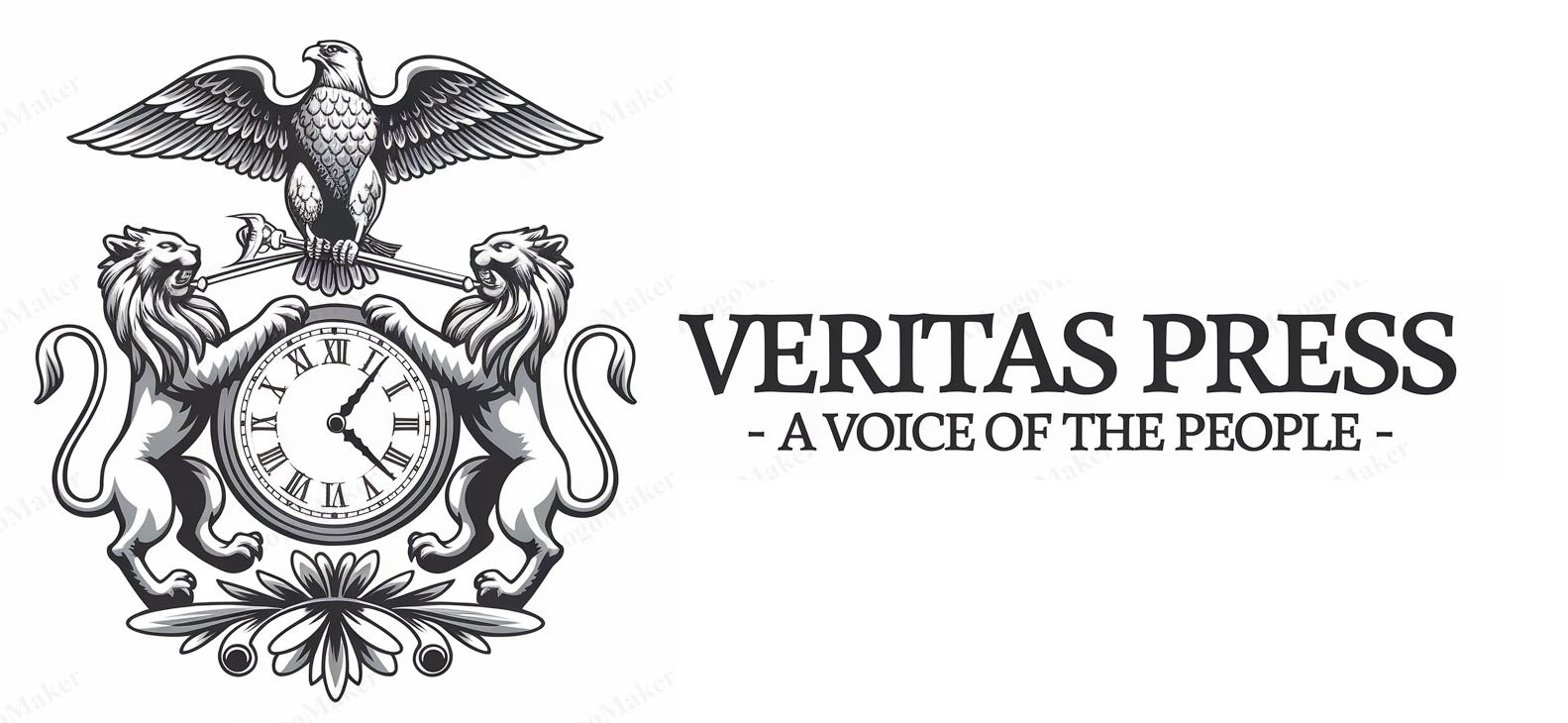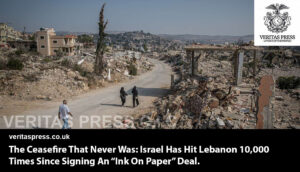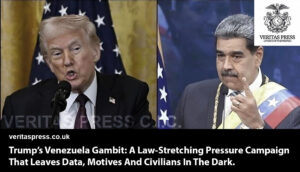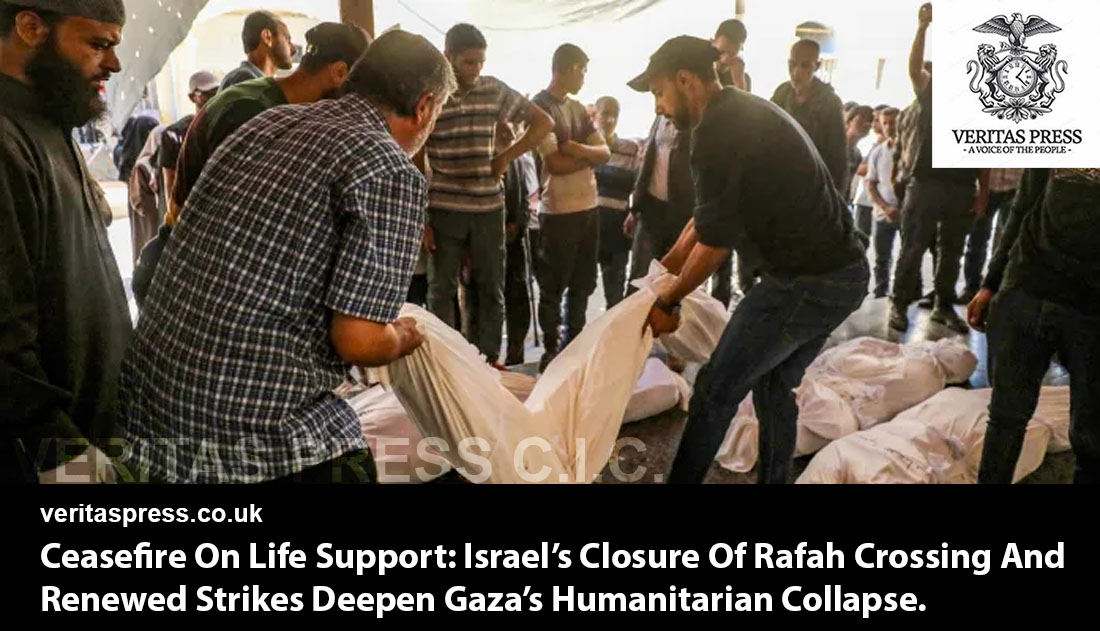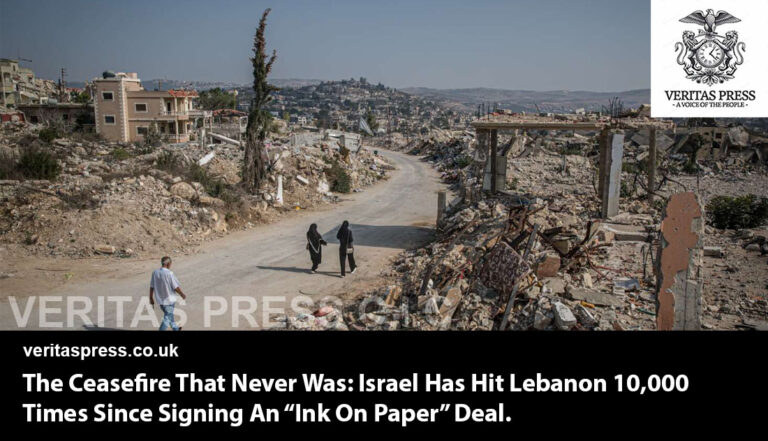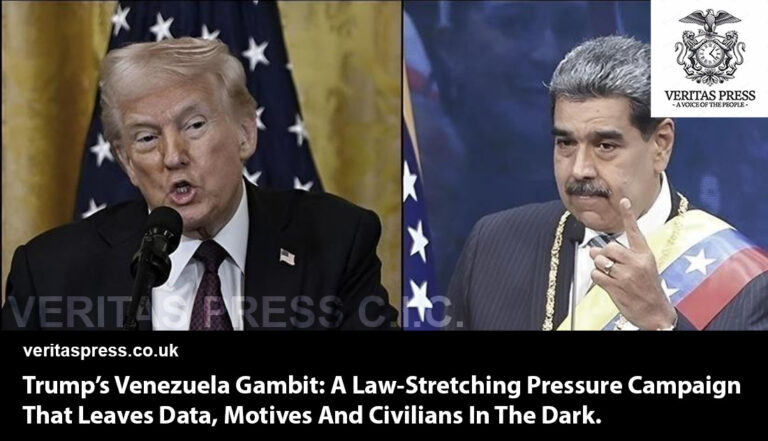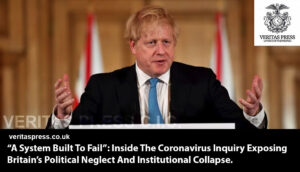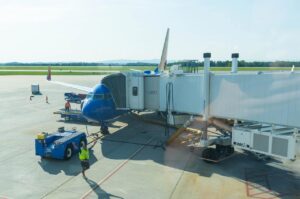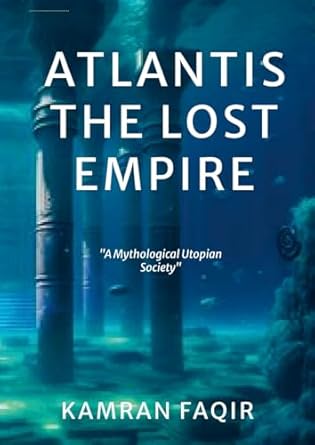Press Release: Veritas Press C.I.C.
Author: Kamran Faqir
Article Date Published: 19 Oct 2025 at 12:01 GMT
Category: Middle-East | Palestine-Gaza-West Bank | Ceasefire On Life Support
Source(s): Veritas Press C.I.C. | Multi News Agencies

Business Ads
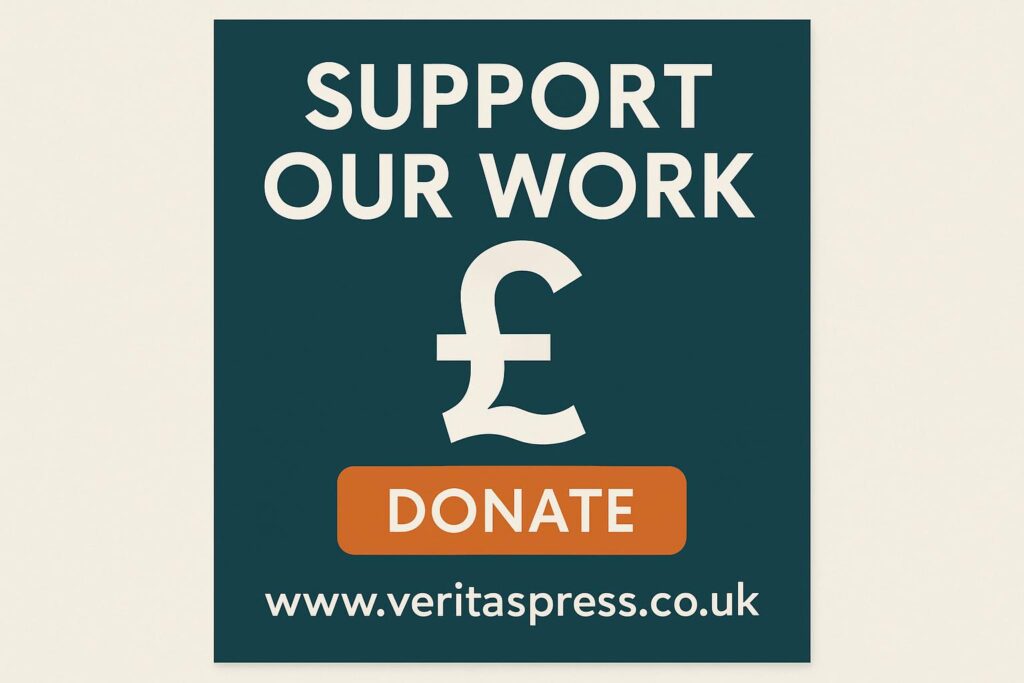

A Fragile Truce Under Fire:
The already fragile ceasefire in Gaza is teetering on the brink after Israel closed the Rafah border crossing and resumed limited airstrikes across the enclave, moves that Palestinian officials, aid agencies, and rights groups say amount to collective punishment.
According to Gaza’s Government Media Office, Israeli forces have violated the truce 47 times since it took effect in early October, killing at least 43 Palestinians and injuring more than 140. The attacks included artillery fire, drone strikes, and incursions near Rafah and Khan Younis.
The Israeli government insists the operations target militants behind “security threats” and insists the border will remain sealed “until further notice,” explicitly linking its reopening to the return of the remains of Israeli captives.
Aid Blocked, Patients Trapped:
The Rafah crossing, Gaza’s primary gateway to Egypt and the outside world, remains shut for both goods and people. Humanitarian organisations describe the closure as catastrophic.
“This is not a security measure, it’s the weaponisation of aid,” said a senior field coordinator with Médecins Sans Frontières (MSF), who requested anonymity for safety reasons. “Patients needing evacuation are trapped, medical supplies are stalled, and hospitals are collapsing.”
The United Nations Emergency Relief Coordinator, Tom Fletcher, warned this week that Gaza requires a “massive boost in emergency aid,” saying that thousands of trucks and hundreds of thousands of tonnes of food, medicine, and fuel remain stranded at Egyptian and Israeli border points.
“The aid that has entered since the fighting subsided is a drop in the ocean,” Ismail al-Thawabta, head of Gaza’s media office, told Reuters. “People are dying not from bombs, but from hunger, thirst, and infections.”
Eyewitness Accounts From Rafah:
Residents of Rafah described renewed explosions and chaos after Israeli strikes hit areas near the closed crossing.
“There was a huge blast, buildings shook, people were running,” said Ahmed Abu Youssef, a local shopkeeper who spoke to Al Jazeera. “We thought the ceasefire meant quiet, but the war never really stopped.”
Medical staff at Nasser Hospital in Khan Younis said they are overwhelmed. “If they had warned us, we would have prevented this catastrophe,” said Dr. Mohammed Saqr, the hospital’s head of nursing. “We are forced to choose which patients to save. There’s no fuel, no oxygen, and no surgical supplies.”
Health officials say more than 94% of Gaza’s hospitals have been damaged, with many operating without electricity or running water. The World Health Organisation warns that Gaza’s health system is “in free fall.”
Israel’s Justification And The ‘Yellow Line’:
Israeli military spokespeople claim that militants have launched “multiple attacks” on forces near the so-called “yellow line,” a buffer zone area inside Gaza. They cited IED detonations and sniper fire as justification for targeted airstrikes.
However, independent journalists and analysts say the situation is more complicated. Some reports suggest the presence of armed local militias, notably factions tied to the Yasser Abu Shabab clan, who were previously armed by Israel to counter Hamas. These groups now reportedly control pockets of territory, sparking clashes that blur the line between counterterrorism and internal proxy warfare.
Analyst Mariam Barghouti told Middle East Eye that “Israel’s use of clan-based militias is both a short-term tactic and a long-term destabilisation tool, it fractures Gaza’s social fabric while maintaining plausible deniability for ground operations.”
Hostage Remains As Political Leverage:
Over the weekend, Hamas handed over two bodies to the International Committee of the Red Cross, one identified by Israel as Ronen Engel, a hostage killed earlier in the war.
But Israeli Prime Minister Benjamin Netanyahu’s office said the Rafah crossing will remain closed until the remains of all Israeli captives are returned, effectively conditioning humanitarian access on political demands.
Hardline ministers seized the moment to push for renewed combat. National Security Minister Itamar Ben Gvir called for a “return to full-scale fighting,” while Finance Minister Bezalel Smotrich posted “War!” on social media, remarks seen as pressuring Netanyahu to abandon the ceasefire entirely.
Hamas, meanwhile, condemned Israel’s stance as “a flimsy pretext for continued aggression,” saying that recovery of many remains is impossible without heavy equipment to clear rubble. Gaza’s civil defence agency estimates that thousands of bodies remain trapped beneath destroyed neighbourhoods.
Humanitarian Law Violations And Collective Punishment:
Legal experts and humanitarian groups argue that using border closures and aid restrictions as political leverage violates international humanitarian law. The Fourth Geneva Convention explicitly prohibits the collective punishment of civilians.
“The closure of Rafah to pressure Hamas is not a defensive act; it’s a punitive one,” said Raji Sourani, director of the Palestinian Centre for Human Rights in Gaza. “This is a deliberate policy designed to break civilian resilience.”
Human rights monitors, including Amnesty International and Human Rights Watch, have repeatedly accused Israel of using starvation, siege, and systematic targeting of infrastructure as weapons of war.
Media And NGO Investigations Point To A Pattern Of Intent:
Investigations by Reuters, AP, and The Guardian using satellite and geospatial imagery have challenged Israeli claims that many strikes were “responses to militant activity,” showing instead a repeated pattern of targeting hospitals, shelters, and aid convoys.
Field journalists who documented Israel’s earlier operations in northern Gaza report similar tactics: unannounced strikes near aid lines, deliberate obstruction of humanitarian convoys, and siege-induced displacement of civilians from entire districts.
“Every closure, every delay, every strike is part of a calculated policy to make Gaza uninhabitable,” said Yara Eid, a Palestinian journalist who has been reporting from southern Gaza since the war began. “People are not dying by accident. They are being starved and bombed into submission.”
Ceasefire Violations And Accountability:
Despite the ceasefire, Gaza’s health ministry reported fresh casualties in Rafah and Khan Younis this week. Israel’s military has not released independent verification of its claims of attacks by militants, while Gaza’s casualty counts remain difficult to independently confirm due to restricted access for journalists and aid monitors.
Rights groups are urging independent UN investigators to be granted unfettered access to Gaza to verify alleged war crimes and secure evidence of violations by all parties.
“Without full transparency and forensic access, the truth will again be buried beneath the rubble,” said Jan Egeland, Secretary-General of the Norwegian Refugee Council.
What Lies Ahead:
Diplomatic sources in Cairo and Doha say Egypt and Qatar are trying to salvage the truce by decoupling humanitarian access from hostage negotiations. But with Israel’s far-right ministers rejecting any concessions and Washington’s muted response, few expect a breakthrough soon.
Analysts warn that the situation could tip either into renewed full-scale war or a slow-motion siege, a “managed stalemate” that starves Gaza while keeping the political optics of restraint.
As Dr. Saqr from Nasser Hospital put it, “The guns may have quieted for now, but people are dying just the same. Only this time, it’s slower.”
Conclusion: Siege As Strategy, Ceasefire As Illusion.
What is unfolding in Gaza today is not a breakdown of a ceasefire; it is the continuation of a policy. The repeated violations, targeted strikes, and indefinite closure of the Rafah crossing are not isolated breaches but symptoms of a systemic Israeli strategy: to manage Gaza’s destruction while avoiding the diplomatic cost of formally declaring war.
By maintaining the illusion of a truce, Israel has built a hybrid siege, where the tools of warfare, starvation, deprivation, and bombardment are deployed under the cover of “security operations.” The closure of Rafah, the throttling of aid convoys, and the obstruction of medical evacuations amount to a policy of collective punishment, prohibited under international law. Yet these acts are sanitised through bureaucratic language, “security reviews,” “conditional reopenings,” “targeted responses.”
Human rights experts call this administrative warfare: the use of borders, permits, and access restrictions as weapons to control life and death. “Every delay at a crossing is a calculated decision,” said Omar Shakir, Israel-Palestine Director at Human Rights Watch. “Israel has turned humanitarian control into a form of domination, a way to make Gaza ungovernable, unlivable, and entirely dependent on its goodwill.”
Alongside this physical siege runs an equally deliberate information offensive. Israeli officials and military spokespeople have launched what analysts describe as an orchestrated psy-ops and media control campaignshaping public perception through selective leaks, disinformation, and suppression of critical narratives. Independent journalists are blocked from entering Gaza, while human rights organisations report escalating online harassment and smear campaigns against local reporters and aid workers. The result is a tightly managed narrative portraying continued attacks as “defensive” and dissent as “terror sympathy.”
“The information war is as central as the air war,” said Hagar Shezaf, a journalist for Haaretz who covers military censorship. “It’s about controlling what Israelis and the world see, to manufacture legitimacy where none exists.”
The manipulation of the very word “ceasefire” is part of Israel’s full-spectrum psychological warfare, a campaign designed to rewrite the vocabulary of occupation. Military officials and government spokespersons flood international media with carefully crafted briefings, framing every airstrike as “retaliation” and every civilian death as “collateral.” The goal is not only to justify continued violence, but to desensitise audiences to it. “Language is Israel’s softest weapon,” said Nour Odeh, a Palestinian analyst and former journalist. “When they say ‘ceasefire,’ they mean control; when they say ‘defence,’ they mean domination.” Through this semantic inversion, Israel turns the language of peace into an instrument of war, one that masks systematic aggression, confuses accountability, and renders Palestinian suffering invisible behind official euphemisms.
Critics argue that this propaganda apparatus not only distorts public understanding but also normalises civilian suffering and deflects accountability. “By manipulating the narrative, Israel sustains impunity,” said Francesca Albanese, the UN Special Rapporteur on the occupied Palestinian territories. “It’s a psychological shield for policies that would otherwise be indefensible.”
Meanwhile, Netanyahu’s political calculus remains inseparable from the humanitarian catastrophe. Facing mass protests at home and pressure from far-right ministers, his government has weaponised Gaza’s siege to project strength and silence dissent. The Rafah crossing, once Gaza’s lifeline, is now a tool of coercion, opened or closed according to political expedience.
As UNRWA’s Gaza Director Thomas White warned, “Without unrestricted humanitarian access, every ceasefire will collapse under the weight of deliberate deprivation.”
The international response has been complicit in this information war. Western governments, particularly the United States and the European Union, have echoed Israeli talking points while funding digital surveillance and censorship programs that target pro-Palestinian voices. Student activists, journalists, and humanitarian workers have faced suspensions, visa cancellations, and online blacklisting under the pretext of “combating extremism.” By adopting Israel’s framing and amplifying its disinformation, Washington and Brussels have become active participants in a global narrative siege, one that dehumanises Palestinians and erodes the very notion of journalistic truth.
For Gaza’s two million besieged residents, the message is clear: this is not peace, nor even a pause; it is the continuation of war through other means. Without accountability, an end to the blockade, and protection for truth-telling voices, the ceasefire will remain what it has become, a managed illusion in a war without end.
As Mohammed al-Najjar, a paramedic in Rafah, put it:
“They say the fighting stopped. But the fear, the hunger, the silence, they are still here. The war never left us. It just changed its language.”
